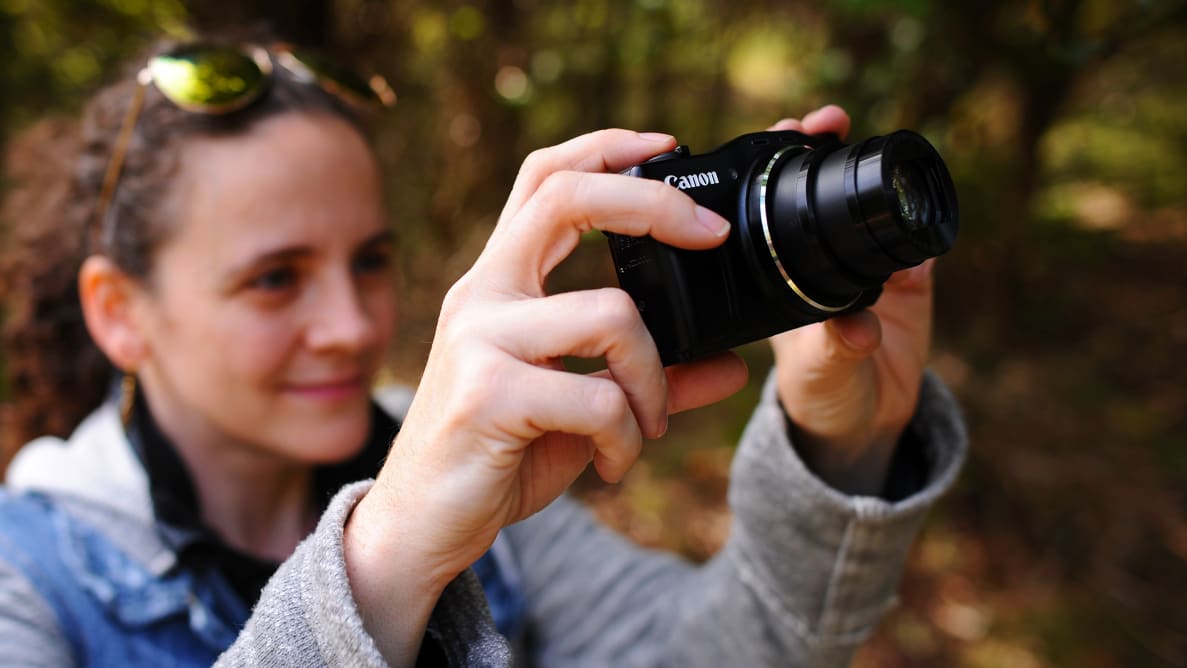One area where they fall short? Optical zoom. There's no substitute for a good ol' fashioned zoom lens, and when you want a camera for dance recitals, plays, sports photography, and vacations—you want a camera with heaping helping of optical zoom.
The Canon PowerShot SX710 HS (MSRP $349.99) is exactly such a camera, with an impressive 30x optical zoom in a body that can easily fit in a jacket pocket. Just like last year's PowerShot SX700 HS, the SX710 promises all the reach you'd need in an easy-to-use, responsive camera.
Unfortunately, this isn't all it's cracked up to be. The SX710 is indeed a fast, responsive camera, and the 30x zoom is useful if it's what you really need. But for $350 you can quite easily find a shooter that takes higher quality images. Unless you absolutely need this much optical zoom, there are better options out there.
Design & Handling
Canon's put the travel zoom formula on repeat.
Like most point-and-shoots these days, the Canon SX710 HS has a compact shape that resembles a squarish bar of soap. It's a bit thicker than most, with a round protrusion where the telescoping 30x zoom lens lives. Besides that, you'll also find a plastic hump with a leatherette insert, giving you just enough grip to keep the camera steady.
You'll need it, because at full zoom the lens sticks several inches out from the body. You control the zoom in the usual way, with a zoom slider ringing the shutter button on top of the camera. Next to this you'll find the power and video record buttons, as well as a pop-up flash.
{{ photo_gallery "tour" }}
On back of the camera there's a mode dial, which is nice for advanced shooters and beginners alike; there's a full suite of manual modes, and if you screw something up you can just pop it into the green "Auto" mode and all will be well. On the back there are also a variety of physical controls for accessing stored photos, the menu, and common controls (includng white balance, drive mode, focus mode, etc.).
The menu—as it is on most Canon point-and-shoots—is very simple and legible. If you've used a Canon point-and-shoot before this should instantly feel familiar. If you haven't, there's not much to learn. The only thing that can be a bit odd is that most of the important controls aren't in the actual menu—which you access via the "menu" button—but are brought up on the rear LCD by pressing the center "Func. Set" button.
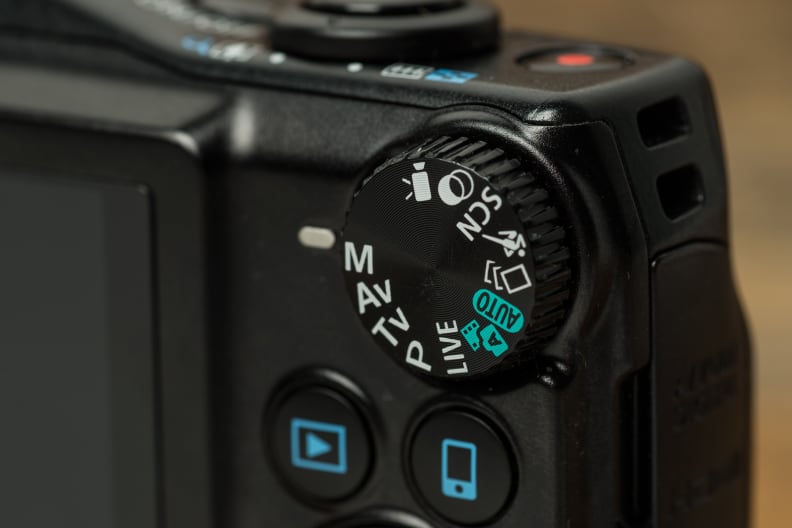
A mode dial unlocks lots of possibilities.
All in all, the SX710 HS is almost exactly the same as last year's SX700. Canon doesn't typically change much from year to year, because it knows what works. This camera isn't perfect, but even if you're replacing a Canon point-and-shoot from four or five years ago, you'll feel right at home with the SX710 HS.
Unfortunately, these kinds of compact travel zooms have always presented something of a Catch-22. On the one hand they're compact and can travel with you anywhere (hence the name) while providing plenty of zoom. But such a compact camera doesn't have much room for grip, making it nearly impossible to get stable shots at full zoom without sitting the camera on a stable surface or tripod.
{{ photo_gallery "design" }}
Features
Fun, creative, and automatic—but advanced shooters will be disappointed.
For a camera that's aimed at novices, the SX710 HS does have quite a few manual controls. Though the camera doesn't have a huge range of apertures and shutter speeds to choose from, there are aperture- and shutter-priority modes, as well as full manual and program modes.
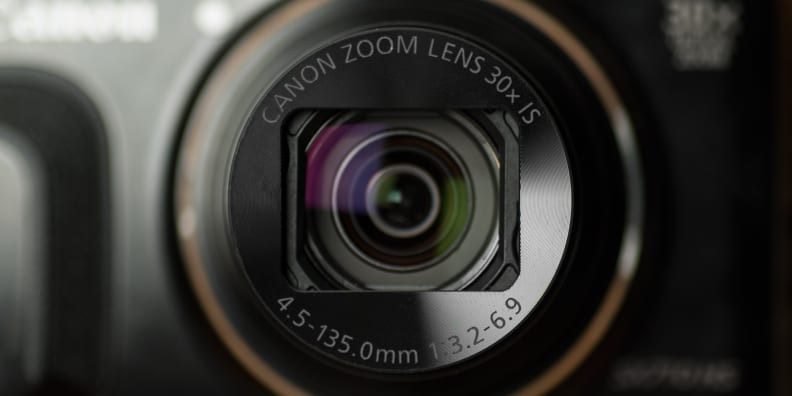
For better or worse, this camera is defined by its lens.
If you have zero clue what those words mean, that's fine; the SX710 HS—like all Canon point-and-shoots—is designed to be approachable enough for even complete beginners. To that end the camera includes basic Auto modes, as well as simple scene modes such as Portrait, Snow, and Handheld NightScene that empower shooters in unforgiving situations.
Complementing these are two other beginner-friendly modes: Creative Shot and Live View Control. Creative Shot is something we've seen on other Canon cameras and it works by taking a short burst of photos every time you hit the shutter button. The camera then applies a number of different filters and crops to create several different versions of the shot. This leaves most of the creativity to the camera, but it gets some cool results.
{{ photo_gallery "creativeshot" }}
Live View Control only takes a single photo, but it lets you take more direct control with three simple sliders: Dark/Light, Neutral/Vivid, and Cool/Warm. Using these, you can frame your shot and then use the d-pad to adjust the sliders until you get the results you want. It's the same process an advanced shooter would go through, but instead of adjusting things like aperture, shutter speed, color balance, and white balance, the camera employs easy-to-understand language.
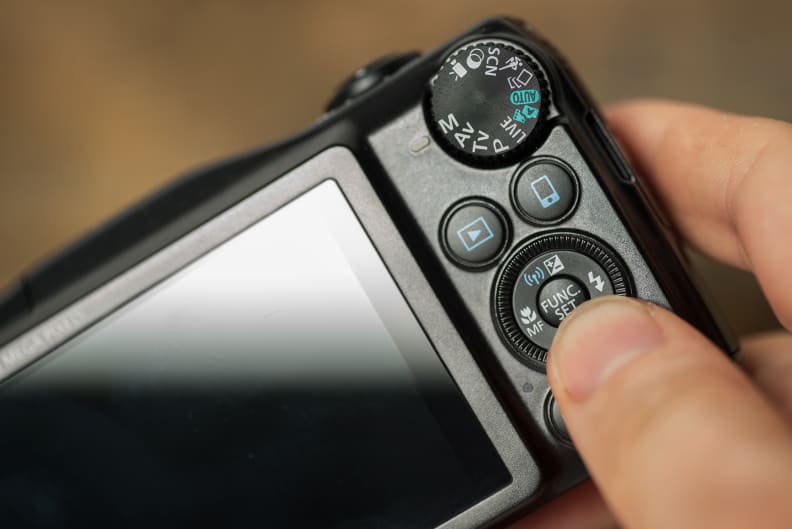
The camera is straightforward and easy to operate.
For video, there unfortunately aren't too many new options. The camera still tops out at just 1080p, though it does capture video at 60fps. The video quality isn't that great, and many newer smartphones that can record 4K video will easily outdo it. Again, the main benefit here is the 30x zoom, though again at full zoom it's nearly impossible to keep the camera steady.
Performance
The SX710 HS leaves a lot to be desired, unless you just want zoom.
From an engineering standpoint, it's impressive that Canon can squeeze such a huge optical zoom range in a camera barely bigger than a deck of cards. But if you're laying down your hard-earned money for a camera, you expect results. And while the SX710 HS isn't the worst camera we've ever tested, there are some glaring issues to be aware of.
{{ photo_gallery "zoom" }}
In our performance tests, the SX710 HS performed about as well as we expected. Even though it has a new 20-megapixel sensor, this is still the same formula as last year's SX700. And just like last year, the camera runs into many of the same issues, with iffy low light image quality and performance that breaks down at the furthest ends of the zoom range.
On the bright side, it's not all bad. The areas that are more driven by software—like color accuracy and white balance—are excellent. The SX710's software also tries to make up for the lens's shortcomings by enhancing edge sharpness. This results in some nasty halos around edges when you view them at 100%, but if you're just putting photos on Facebook or making small prints they'll look just fine.
Again though, the one area where software just can't do a thing is in low light. In even moderate low light photos with the SX710 HS have nasty digital grain. The camera reins this in with software-based noise reduction, but to do so it wipes away a lot of fine detail.
In low light (especially at full zoom) the camera's autofocus performance also takes a major hit. Though it's not great to begin with, at full zoom the SX710 HS struggles to reliably lock onto a still subject. This makes the camera a poor choice if you're trying to capture action (such as indoor sports) from a distance. You can do it with enough trial and error, but it's unreliable at best.
{{ photo_gallery "sample-photo" }}
Conclusion
Just like last year, this isn't a bad option—for the right buyer.
With a retail price starting at $350, the Canon PowerShot SX710 HS better be good. After all, while $350 was a fair price to pay for a camera like this a few years ago, these days you can get a lot more for your money. With the camera market's struggles, there's never been a better time to go shopping in the bargain bin, with cut-rate deals to be found on everything from point-and-shoots to interchangeable lens cameras.
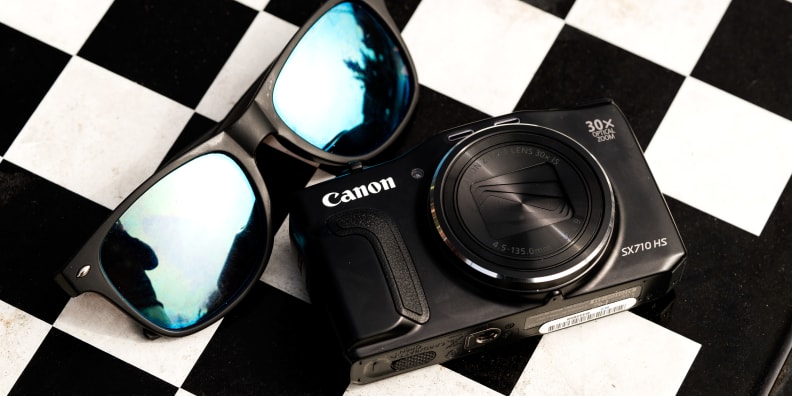
Unless you need DSLR-quality shots, it's tough to argue with a 30x zoom in your pocket.
That's remarkable, and it makes a camera like the SX710 HS a tough sell at its full price. While it's a very good point-and-shoot camera, it really satisfies three key needs: it's compact, easy to use, and it has a lot of zoom. If you can bend on any of those things, you can absolutely get a higher quality camera for the same money. {{amazon name="Canon PowerShot S120 12.1 MP CMOS Digital Camera with 5x Optical Zoom", asin="B00EFILNV8", align="right"}}
For instance if you just want a good compact camera and are okay with less zoom, Canon's own PowerShot S120 takes better photos and is just as easy to use. If you're ready to take the next step you could even step up to Canon's entry-level DSLR, the Canon Rebel T5, for under $400. It's not our favorite DSLR, but it takes better photos than almost any point-and-shoot. There are even compact mirrorless cameras like the Olympus PEN E-PL6 that can be had, with a kit lens, for the same money. It's a buyer's market.
That said, if your wish list is firm and lines up with exactly what the SX710 HS is offering, then it's probably your best bet right now. While you could opt for last year's SX700 HS and save some money, the SX710 is sharper, more responsive, and it'll also drop in price as time marches on. For the right buyer—and at the right price—that's enough to make it a worthwhile purchase.
By the Numbers
Taking a look at the raw performance of the Canon SX710 HS, what you see is a fairly standard travel zoom. Nothing in particular will knock your socks off, but the shooter does suffer the predictable setback of diffraction when you really crank that zoom.
Sharpness
Like most travel zooms, the sharpness offered by this Canon shooter isn't exactly the greatest, but it works for quick snaps. Just be aware that sharpness drops off significantly the farther you zoom out. Sharpness starts at an average of 2226 line widths per picture height with the zoom at minimum, which drops to 1869 lw/ph at the lens' midpoint, and bottoms out 1729 lw/ph.
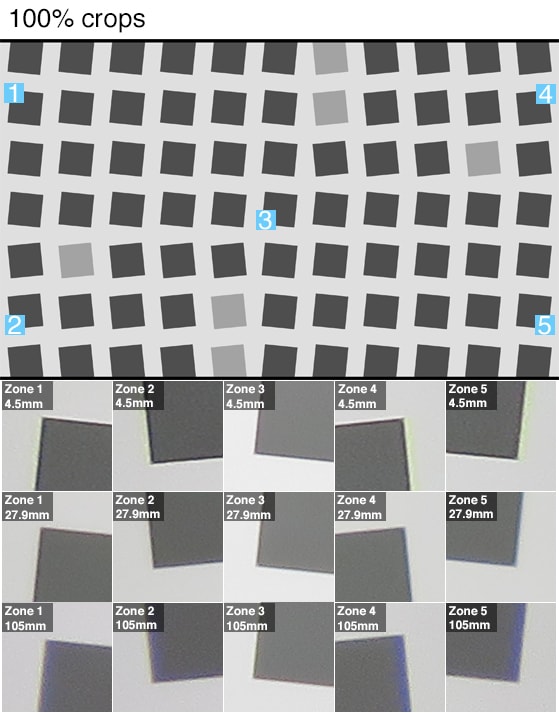
Zoom destroys fine edges, even in ideal conditions.
I will say that those numbers are quite inflated due to software oversharpening, so you may notice some haloing on hard edges here and there. Or not. Really, this is only going to be obvious when you go pixel peeping, so not many worries here.
You won't notice any barrel or pincushion distortion, and chromatic aberration—the presence of color where it shouldn't be on hard edges—doesn't make much of an appearance either. While this isn't going to be a big concern for most shooters looking at this camera, it's comforting to know it's at least without glaring faults.
Color Accuracy and White Balance
Color performance is best with the MyColors option set to "Off." Once there, ∆C 00 (saturation corrected) error sits at 2.17 with an overall picture saturation of 117.3%. You'll probably notice a particular vividness of reds, greens, and blues if you are particularly observant.
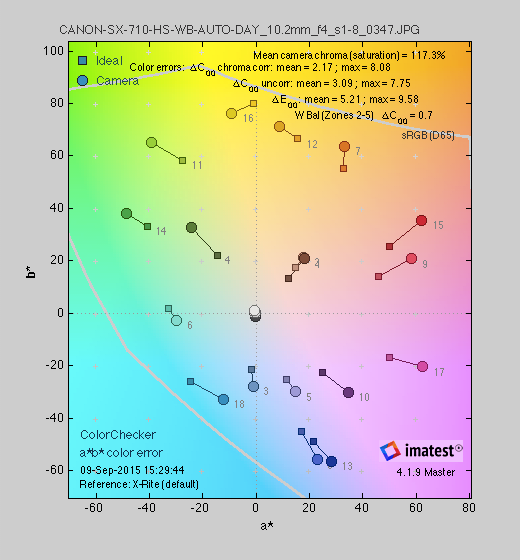
This shooter's color performance is great, though a bit oversaturated.
White balance, on the other hand, is hit or miss. If you're shooting in an environment lit by daylight or fluorescent lighting, color temperature is spot-on. If you're shooting in incandescent (tungsten) lighting, you'll see a distinct orange tint to all of your shots.
Typically a variance of about 1000 kelvin is what we see from "good" point and shoots in incandescent light, but the SX710 HS—even on several re-tests—posts an error of 2000+ kelvin in incandescent light.
Noise
Noise is an issue for the SX710 HS, but that's not terribly surprising given its sensor size and megapixel count. With no noise reduction options, what you see is what you get.
When it comes time to look at the gross noise levels, the story is disheartening, but nothing out of the ordinary. At base ISO, noise hits a whopping 0.89%, which is above average for just about any camera. At ISO 1600, noise crosses the 2% "irredeemably crappy" threshold.
Noise reduction is fairly hit or miss, but obviously the lower the ISO setting, the less detail is lost. Absolutely keep it under 800 if you can.
Video
Video works acceptably well in a pinch, though the quality leaves something to be desired. If you're in bright light, though, you have nothing to fear.
When your scene is well-lit, the SX710 HS is able to resolve 600 line-pairs per picture height both horizontally and vertically, while that number drops to 450 in low light (60 lux). While that's not amazing or anything, it's perfectly usable for most.
However, when the lights go down and you're in a darker setting, you'll find that your picture becomes almost unusable. In our labs, the camera wasn't able to maintain a 50 IRE image (broadcast quality) any lower than 13 lux. That's brighter than most birthday parties, so take that as you will.
Meet the tester
TJ is the former Director of Content Development at Reviewed. He is a Massachusetts native and has covered electronics, cameras, TVs, smartphones, parenting, and more for Reviewed. He is from the self-styled "Cranberry Capitol of the World," which is, in fact, a real thing.
Checking our work.
Our team is here for one purpose: to help you buy the best stuff and love what you own. Our writers, editors, and lab technicians obsess over the products we cover to make sure you're confident and satisfied. Have a different opinion about something we recommend? Email us and we'll compare notes.
Shoot us an email
